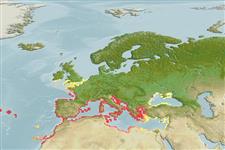Common names from other countries
Malacostraca |
Decapoda |
Grapsidae
Environment: milieu / climate zone / depth range / distribution range
Ecology
Benthic. Tropical; 53°N - 26°N, 32°W - 37°E
Eastern Atlantic and the Mediterranean.
Length at first maturity / Size / Weight / Age
Maturity: Lm ? range ? - ? cm Max length : 4.0 cm CW male/unsexed; (Ref. 842)
Intertidal (Ref. 107021). It is found on rocks from upper to middle shore, also in crevices in breakwaters and pier piles or similar habitats (Ref. 842). Omnivore but cannot be simply considered an opportunistic feeder (Ref. 107021).
Life cycle and mating behavior
Maturity | Reproduction | Spawning | Eggs | Fecundity | Larvae
Members of the order Decapoda are mostly gonochoric. Mating behavior: Precopulatory courtship ritual is common (through olfactory and tactile cues); usually indirect sperm transfer.
Debelius, H. 2001. (Ref. 842)
IUCN Red List Status
(Ref. 130435: Version 2025-1)
CITES status (Ref. 108899)
Not Evaluated
Not Evaluated
Threat to humans
Human uses
Fisheries: commercial
| FishSource |
Tools
More information
Life cycleReproductionMaturityFecunditySpawningEggsEgg developmentLarvae PhysiologyOxygen consumption
Human RelatedStamps, coins, misc.
Internet sources
Estimates based on models
Preferred temperature
(Ref.
115969): 17.6 - 19.9, mean 18.8 (based on 394 cells).
Resilience
High, minimum population doubling time less than 15 months (K=0.83-1.14).
Fishing Vulnerability
Low vulnerability (10 of 100).
Price category
Unknown.
